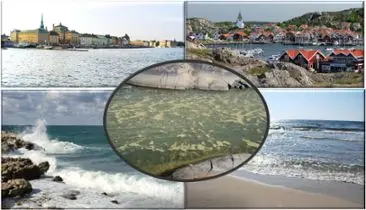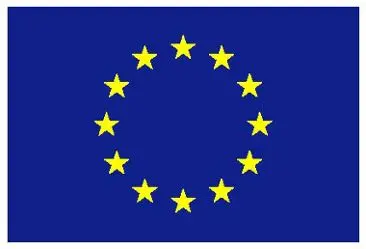COCOA – Nutrient COcktails in the COAstal zone of the Baltic Sea
The objective of COCOA is to identify major pathways of nutrients and organic material in various coastal ecosystems around the Baltic Sea.

Olika skärgårds- och kustområden. Algblomning i Stockholms skärgård i juli 2008 (figuren i mitten).
An ensemble of biogeochemical models will be used in combination with field studies at different coastal study sites around the Baltic Sea to identify major pathways of nutrients and organic material in various coastal ecosystems, like for instance river-dominated estuaries, lagoons, archipelagos and embayments with restricted water exchange.
Nutrients and organic matter are transformed and retained along the land-sea continuum, and COCOA will quantify how physical and chemical conditions as well as the biological components of the coastal zone affect the biogeochemical processes. Improved estimates of the nutrient retention capacity will be obtained using models to integrate the processes over the ecosystem. These results will be scaled up to the entire Baltic Sea coastal zone by developing a catalogue of coastal ecosystems with hydromorphological, physical, chemical and biological information and projecting the results from the dynamical models to the entire coastal zone.
The project will investigate if transformation and retention processes may have changed over time, and how coastal ecosystem services are affected by these changes. As a result, COCOA will outline management responses to improve the ecological status for coastal ecosystems degraded by eutrophication.
Role of SMHI
SMHI is leading the work package 5 in the Cocoa project. In this work package the process understanding and the process descriptions in the state-of-the-art biogeochemical models of the Baltic Sea coastal zone will be improved.
The carbon and nutrient fluxes between land, coastal zone and open sea as well as between water and sediments will be quantified. The effect of benthic primary producers and fauna on nutrient and organic matter fluxes will be included in the models and assessments of the ecological status at the study sites will be performed.
About the project
Project partners
Project coordinator: Jacob Carstensen, Aarhus University, Denmark
Project vice-coordinator: Daniel Conley, Lund University, Sweden
Project participants:
- Erik Bonsdorff, Åbo Academi University, Finland
- Bo Gustafsson, Stockholm University, Sweden
- Anna-Stiina Heiskanen, Finnish Environment Institute, Finland
- Urszula Janas, University of Gdansk, Poland
- Alexey Maximov, Zoological Institute RAS, Russia
- Markus Meier, Swedish Meteorological & Hydrological Institute, Sweden
- Alf Norkko, Helsinki University, Finland
- Arturas Razinkovas-Baziukas, Coastal Research and Planning Institute, Lithuania
- Caroline Slomp, Utrecht University, The Netherlands
- Colin Stedmon, Technical University of Denmark, Denmark
- Kristina Sundbäck, Gothenburg University, Sweden
- Maren Voss, Leibniz-Institute for Baltic Sea Research Warnemünde, Germany
Funding
This project has received funding from BONUS (Art 185) funded jointly from the European Union’s Seventh Programme for research, technological development and demonstration, and from Baltic Sea national funding institutions.
SMHI’s national support is granted by the Swedish Research Council for Environment, Agricultural Sciences and Spatial Planning (FORMAS).
.webp)
.webp)
.webp)


